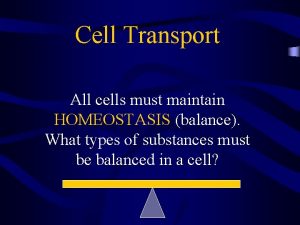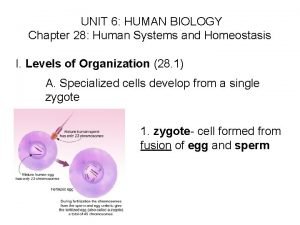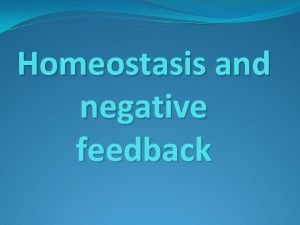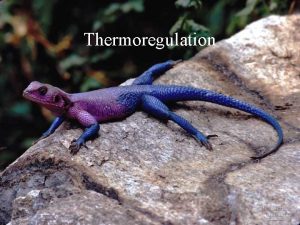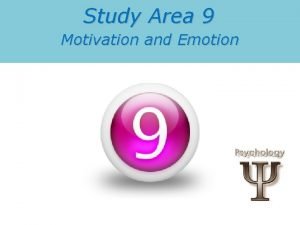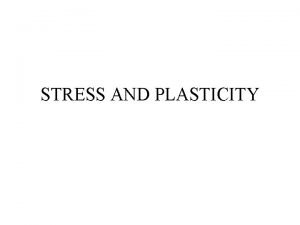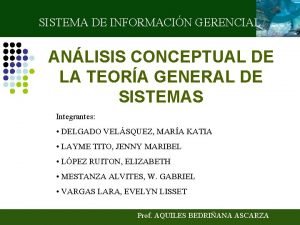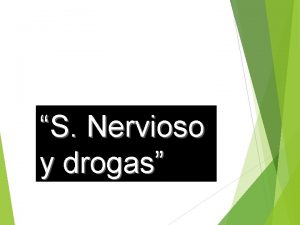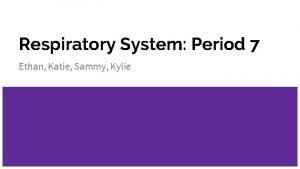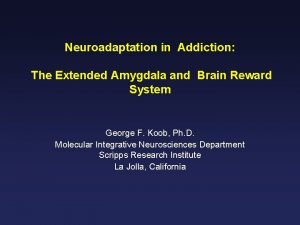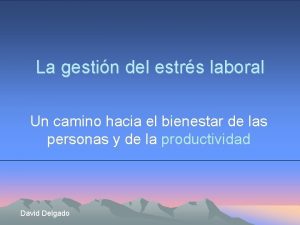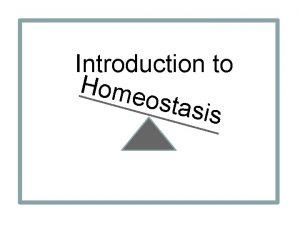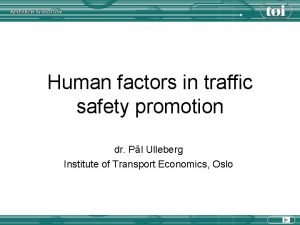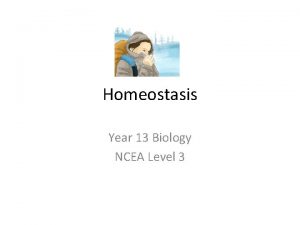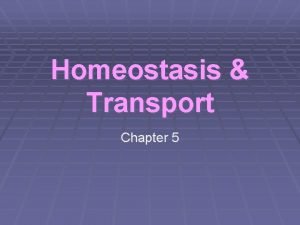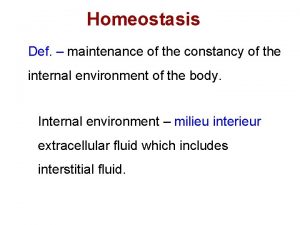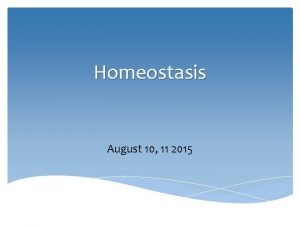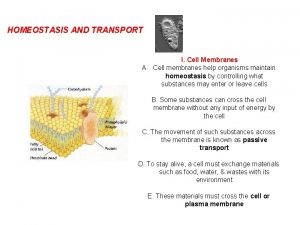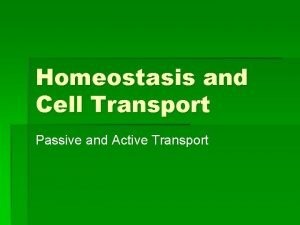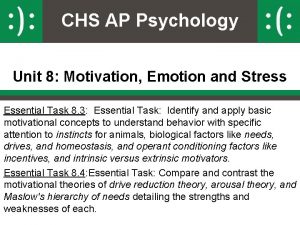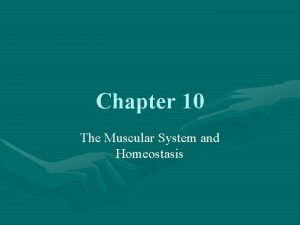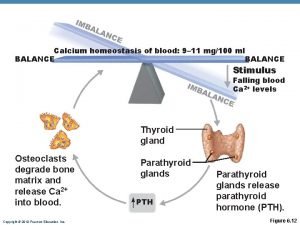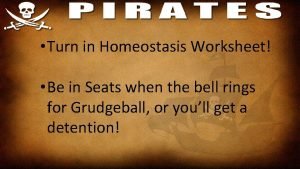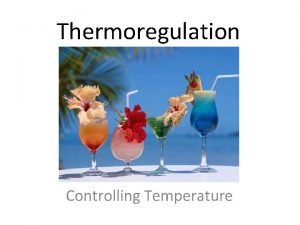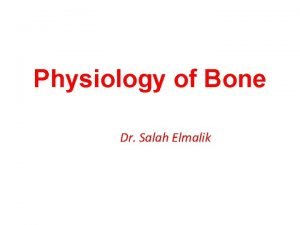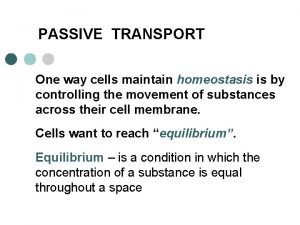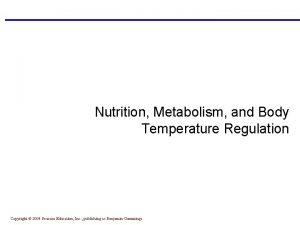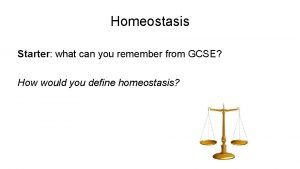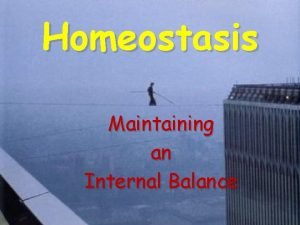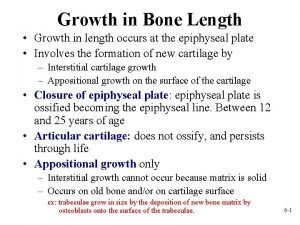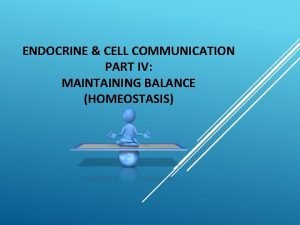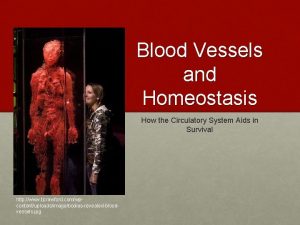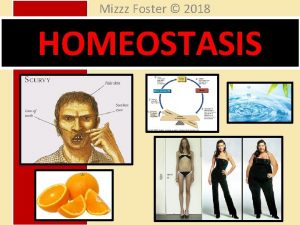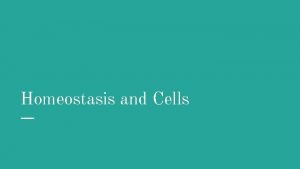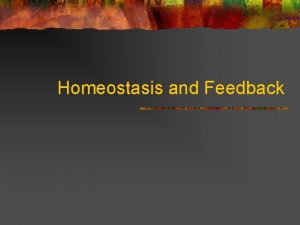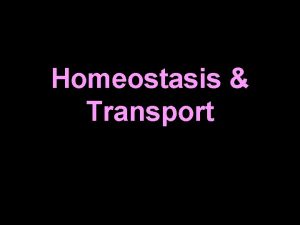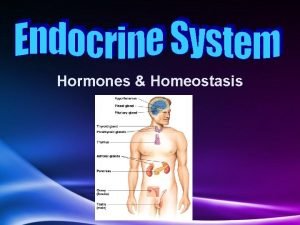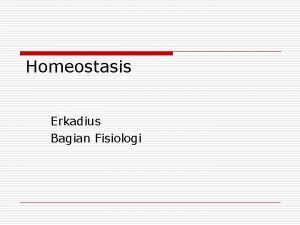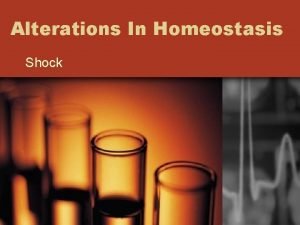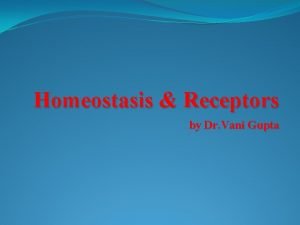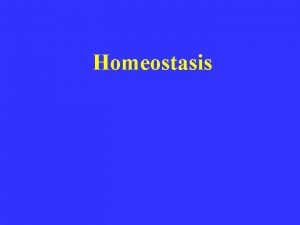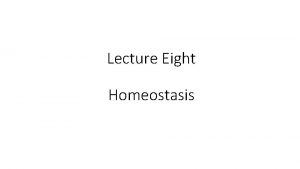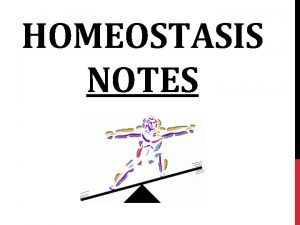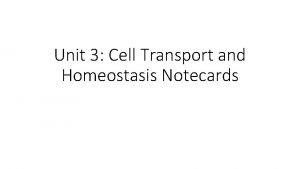HOMEOSTASIS and TRANSPORT A 4 A 4 Homeostasis



















































- Slides: 51

HOMEOSTASIS and TRANSPORT A 4

A 4. Homeostasis and Transport 1. Describe how the structure of the plasma membrane allows it to function as a regulatory structure and/or protective barrier for a cell. 2. Compare the mechanisms that transport materials across the plasma membrane. 3. Explain how organisms maintain homeostasis. 4. Describe how membrane-bound organelles facilitate the transport of materials within a cell.

A 4. Vocabulary plasma membrane phospholipid selectively permeable protein pump diffusion active transport endocytosis isotonic hypertonic hypotonic lipid bilayer impermeable protein channel osmosis facilitated diffusion passive transport exocytosis equilibrium concentration gradient homeostasis

Cell Membrane Structure and function Plasma Membrane • Aka cell membrane • Surrounds the cytoplasm of the cell, controlling what enters and exits • Selectively permeable = some substances cross more easily than others

Cell Membrane Structure and function A phospholipid bilayer • Membranes are made of 2 layers of phospholipids • Each phospholipid has a “head” and two “tails” – The head loves water (polar; hydrophilic) – The tails hate water (nonpolar; hydrophobic) • Nonpolar hydrophobic center determines how easily substances move across the membrane

Cell Membrane Structure and Function DRAW THIS in your NOTES!!

Cell Membrane Structure and Function Permeability Membranes are selectively permeable • Some things cross the membrane (permeable) – Small, nonpolar molecules such as oxygen and carbon dioxide • Ions and polar molecules are repelled by the hydrophobic center and therefore need the help of proteins in the membrane – Ions, polar molecules, proteins, larger particles • Some things can’t cross the membrane (impermeable)

Cell Membrane Structure and Function Membrane Proteins are essential • Stabilize and shape the membrane • Hormones bind to receptors for cell communication • Transport proteins aid in movement of material – Aquaporins = protein channels allow easy passage of water – Protein channels/carriers – Protein pumps

Let’s Build a Model of a cell membrane! • Cotton swabs represent phospholipids • Other components are embedded within the phospholipid bilayer • Can you move the components back and forth?

Cell Membrane Structure and Function Fluid Mosaic Model • The cell membrane acts as a fluid… – It is not rigid – Proteins and phospholipids can move around • The cell membrane is a mosaic… – Many different parts make up the cell membrane

Cell Membrane Structure and Function Membranes inside the cell • Many organelles are surrounded by membranes – EX: Chloroplast, golgi, mitochondria, ER, nucleus, etc. • Endosymbiosis – Theory that suggests that cell organelles were once free living organisms that were captured by a eukaryotic cell

Can you do it? • Give as many names for the boundary of the cell as you can…

Mechanisms of Passive Transport Defined • requires NO energy • Depends on a concentration gradient – Concentration = relative amount of substance – gradient = difference • SUBSTANCE moves from HIGH concentration to LOW concentration • Some materials can pass freely, other materials need a protein channel • Examples: diffusion, osmosis, facilitated diffusion

Mechanisms of Passive Transport is like… A ball rolling down a hill

Mechanisms of Passive Transport 1. Diffusion (a. k. a. simple diffusion) • Passive transport of small nonpolar molecules through the phospholipid bilayer • Equilibrium is reached when there is no more concentration gradient

Mechanisms of Passive Transport 1. Diffusion (a. k. a. simple diffusion) Concentration gradient HIGH LOW EQUILIBRIUM

Mechanisms of Passive Transport 1. Diffusion (a. k. a. simple diffusion)

Mechanisms of Passive Transport 2. Facilitated Diffusion • Passive transport of ions and polar molecules • Relies on protein channels or carrier proteins to help material cross the membrane • EX: glucose transport

Mechanisms of Passive Transport 2. Facilitated Diffusion

Mechanisms of Passive Transport 2. Facilitated Diffusion

Cell Membrane Structure and Function QUICK CHECK Which of the following is NOT an example of passive transport? A. B. C. D. Carbon dioxide crossing vessels in the lung Oxygen dissolved in the blood crosses the membrane of a red blood cell Glucose molecules are transported by a protein carrier Sodium ions move through a protein channel until there is a higher concentration of sodium in the cell

Mechanisms of Passive Transport 3. Osmosis (defined) • Diffusion of water • WATER moves in the direction of higher solute concentration • Water movement causes a change in the volume of a cell • Osmosis plays a role in maintaining homeostasis (osmosregulation) • Aquaporins = protein channels for water to pass

Mechanisms of Passive Transport 3. Osmosis solute water

Mechanisms of Passive Transport 3. Osmosis (how cells respond) • Fluids inside and outside of a cell can be compared in terms of solute concentration – Isotonic = solute concentration is equal – Hypotonic = solute concentration is low – Hypertonic = solute concentration is high

Mechanisms of Passive Transport ISOTONIC Conditions • Amount of water inside = amount of water outside • Water moves back and forth across the membrane equally in both directions • Equilibrium = equal concentrations of water on both sides of the membrane

Mechanisms of Passive Transport HYPOTONIC conditions • Solution contains LOW solute • EX: pure water • Water moves INTO the cell • Cell swells – plant cells are protected by the cell wall – animal cells could burst

Mechanisms of Passive Transport HYPERTONIC Conditions • • Solution contains high solute EX: saltwater Water moves out of the cell Cell shrinks (gets dehydrated) – In plants, cell membrane pulls away from cell wall

Why would plant cells be better off than animal cells? What would happen to the cells of a freshwater fish if it was put into a saltwater tank?


Mechanisms of Active Transport Defined • Requires energy (ATP) • Material flows AGAINST the concentration gradient – From LOW concentration to HIGH concentration • Creates a concentration gradient • Requires protein pumps (need energy to work)

Movement within a cell 1. Protein Pumps • Use ATP energy to move or “pump” material against a concentration gradient • Create and maintain a concentration gradient

Movement within a cell 1. Protein Pumps

Movement within a cell 2. Bulk Transport • • • Used to transport very large molecules or food Requires energy (ATP) Endocytosis = bringing materials into the cell Exocytosis = taking materials out of the cell Cell membrane/vesicles play a role

Movement within a cell 2. Bulk Transport ENDOCYTOSIS EXOCYTOSIS

VISUAL COMPARISON • Take a large piece of paper and divide it into 6 parts • Each section should have a diagram of a mode of transport » » » Diffusion Facilitated Diffusion Osmosis Protein Pumps Endocytosis Exocytosis • Things I’m looking for: phospholipid bilayer, concentration gradients, protein channels/pumps, ATP, direction of movement

Homeostasis Defined • Maintaining stability in the cell or body • Variables within the body can fluctuate – Temperature, p. H, water balance • Process by which an organism monitors and maintains a constant state = homeostatic mechanism

Homeostasis Feedback • Negative feedback = maintains homeostasis (like a thermostat) • Positive feedback = amplifies a change to the system

Homeostasis Thermoregulation (Body Temperature) • Normal body temp = 37 o. C (98. 6 o. F) • When body temp is high, we sweat to release heat • When body temp is low, we shiver to generate heat


Keystone Questions 1. Carbon dioxide and oxygen are molecules that can move freely across a plasma membrane. What determines the direction that carbon dioxide and oxygen move? A. B. C. D. Orientation of cholesterol in the plasma membrane Concentration gradient across the plasma membrane Configuration of phospholipids in the plasma membrane Location of receptors on the surface of the plasma membrane

Keystone Questions 2. A sodium-potassium pump within a cell membrane requires energy to move sodium and potassium ions out of a cell. The movement of glucose into or out of a cell does not require energy. Which statement best describes the movement of these materials across a ac cell membrane? A. Sodium and potassium ions move by active transport, and glucose moves by osmosis B. Sodium and potassium ions move by active transport and glucose moves by facilitated diffusion. C. Sodium and potassium ions move by facilitated diffusion and glucose moves by osmosis D. Sodium and potassium ions move by facilitated diffusion and glucose moves by active transport

Keystone Questions 3. Which example is an activity that a fish most uses to maintain homeostasis within its body? A. B. C. D. Using camouflage to avoid predators Feeding at night to regulate body temperature Moving to deeper water to regulate metabolic wastes Exchanging gases through its gills to regulate oxygen levels.

Keystone Questions 4. Diffusion occurs because A. Molecules are attracted to one another B. Molecules constantly move and collide with one another C. Cellular energy forces molecules to collide with one another D. Cellular energy pumps molecules across the cell membrane

Keystone Questions 5. During diffusion, when the concentration of molecules on both sides of the membrane are equal, molecules will A. Move across the membrane to the outside of the cell B. Stop moving across the membrane C. Continue to move across the membrane in both directions D. Move across the membrane to the inside of the cell

Keystone Questions 6. Why is the phospholipid bilayer only partially permeable to water? A. Water is repelled by the polar tails of the phospholipid B. Water is repelled by the polar head of the phospholipid C. Water is repelled by the hydrophobic tails of the phospholipid D. Water is repelled by the hydrophobic head of the phospholipid

Keystone Questions 7. Which of the following is NOT involved in the transport of molecules by facilitated diffusion? A. B. C. D. ATP phospholipids Protein channels Concentration gradient

Keystone Questions 8. What is one way that facilitated diffusion differs from simple diffusion? A. B. C. D. Facilitated diffusion requires energy input Facilitated diffusion requires membrane proteins Facilitated diffusion requires a concentration gradient Facilitated diffusion requires small, nonpolar molecules

Keystone Questions 9. A pipe carries excess rainwater into a lake. The rainwater has picked up dissolved nitrates from surrounding lawns. Which of the following is a consequence of simple diffusion of the nitrates in the lake? A. A concentration gradient of nitrates is created and maintained B. The total amount of dissolved nitrate in the lake water decreases C. Nitrate concentration decreases in some places and increases in others D. Energy is required to move the nitrates from one end of the lake to the other

Keystone Questions 9. What is a major difference between active and passive transport? A. Active transport moves ions, while passive transport does not B. Active transport requires energy while passive transport does not. C. Active transport involves a concentration gradient while passive transport does not. D. Active transport uses membrane proteins while passive transport does not.

Keystone Questions 10. The human body maintains a constant internal temperature of 98. 6 o. F. Which changes may occur if body temperature rises to 100. 1 o. F? A. Muscle tissue shivers and skin capillaries dilate B. Perspiration increases and skin capillaries dilate C. Muscle tissue shivers and skin capillaries constrict D. Perspiration increases and skin capillaries constrict

Keystone Questions 11. Which is not an example of homeostasis? A. A jogger stops to drink at a water fountain. B. A turtle spends hours sitting on a sunny rock C. A deer seeks out salty foods to add to its diet D. A rabbit hides among grasses to avoid a hawk
 Bioflix activity homeostasis low blood glucose
Bioflix activity homeostasis low blood glucose Bioflix activity homeostasis hormones and homeostasis
Bioflix activity homeostasis hormones and homeostasis Homeostasis and cell transport
Homeostasis and cell transport Primary and secondary transport
Primary and secondary transport Active transport
Active transport Active transport diagram
Active transport diagram Now answer the questions
Now answer the questions Active vs passive transport venn diagram
Active vs passive transport venn diagram Endocytosis vs exocytosis
Endocytosis vs exocytosis Primary active transport vs secondary active transport
Primary active transport vs secondary active transport Bioflix activity membrane transport active transport
Bioflix activity membrane transport active transport Selectively permeable definition biology
Selectively permeable definition biology Chapter 28 human systems and homeostasis
Chapter 28 human systems and homeostasis Negative feedback in communication
Negative feedback in communication Blobfish homeostasis
Blobfish homeostasis Homeostasis example
Homeostasis example Homeostasis mechanisms for regulation of body temperature
Homeostasis mechanisms for regulation of body temperature James lange theory
James lange theory Allostasis vs homeostasis
Allostasis vs homeostasis Teleología ejemplos
Teleología ejemplos Homeostasis del sistema nervioso
Homeostasis del sistema nervioso Kylie knh
Kylie knh Homeostasis vs allostasis
Homeostasis vs allostasis Motivation textbook
Motivation textbook Diferencia entre alostasis y homeostasis
Diferencia entre alostasis y homeostasis Elephant homeostasis
Elephant homeostasis Risk homeostasis
Risk homeostasis Level 3 homeostasis
Level 3 homeostasis How do cells maintain homeostasis
How do cells maintain homeostasis Constancy def
Constancy def What is this picture
What is this picture How do cells maintain homeostasis
How do cells maintain homeostasis Pinocytosis active or passive
Pinocytosis active or passive Ap psychology unit 8 motivation emotion and stress
Ap psychology unit 8 motivation emotion and stress Homeostasis muscular
Homeostasis muscular Metabolismo
Metabolismo Homeostasis blood calcium level (about 10 mg/100ml)
Homeostasis blood calcium level (about 10 mg/100ml) Calcium homeostasis diagram
Calcium homeostasis diagram Homeostasis animals examples
Homeostasis animals examples Cubital olecranal
Cubital olecranal Homeostasis worksheet
Homeostasis worksheet Thermoreceptor
Thermoreceptor Homeostasis blood calcium level
Homeostasis blood calcium level One way cells maintain homeostasis is by controlling
One way cells maintain homeostasis is by controlling Temperature regulation
Temperature regulation How to remember homeostasis
How to remember homeostasis The maintaining of an internal balance
The maintaining of an internal balance Epiphyseal plate
Epiphyseal plate Blood calcium level
Blood calcium level Blood vessels homeostasis
Blood vessels homeostasis Importance of homeostasis in mammals
Importance of homeostasis in mammals Positive vs negative feedback homeostasis
Positive vs negative feedback homeostasis


